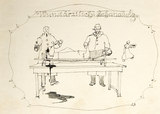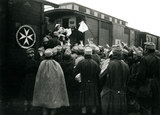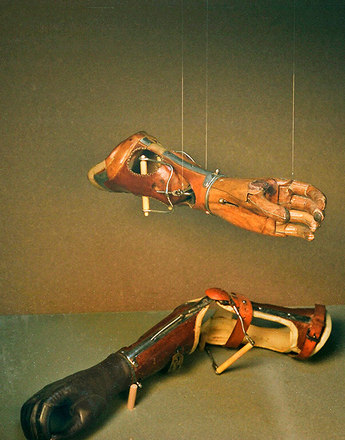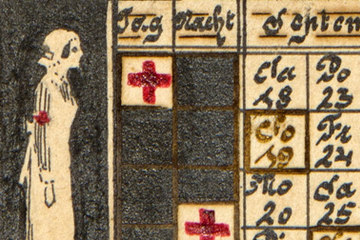-

“Treating wounds,” drawing from war photo album of Leopold Wolf, c. 1916
Copyright: Sammlung Frauennachlässe, Institut für Geschichte der Universität Wien/Fotografie: Angelika Spangel
Partner: Sammlung Frauennachlässe, Institut für Geschichte der Universität Wien -

Order of Malta hospital train, photo
Copyright: Heeresgeschichtliches Museum, Wien
Partner: Heeresgeschichtliches Museum -

View into a military hospital hut, photo
Copyright: Heeresgeschichtliches Museum, Wien
Partner: Heeresgeschichtliches Museum -

Nurses in front of a field hospital of the Order of Malta, photo
Copyright: Heeresgeschichtliches Museum, Wien
Partner: Heeresgeschichtliches Museum
The enormous number of diseased and wounded soldiers in the First World War made detailed organisation of the medical service at the front and behind the lines essential. The instructions by the Austro-Hungarian army for treating the wounded were contained in the service manual Reglement für den Sanitätsdienst des k.u.k. Heeres.
The Austro-Hungarian army had mobile field hospitals, trains and ships as well as fixed facilities at the front and behind the lines. There were also medical equipment depots and the infrastructure of medical organisations like the Teutonic Knights, Knights of Malta or Red Cross. They had their own medical orderlies, field hospitals, hospital ships and mobile material depots.
The medical staff had to be close to the front so as to be able to provide first aid to the wounded, who were bandaged and operated on if necessary at improvised sites just behind the lines. The main centres of the medical corps in the field were the bandaging rooms in the divisional ambulance stations. Operating theatres and bandaging stations were set up there for the immediate care of the wounded and preparation for transport to a field or military hospital. At the start of the war the Austro-Hungarian army had around 160 field hospitals for 200 patients each, 104 mobile reserve hospitals to treat 200 seriously wounded soldiers each, and 47 field hospitals to treat 500 lightly wounded soldiers each. In 1917 the mobile reserve hospitals and field clinics were transformed into field hospitals. Many complaints submitted to the army command talk of the inhumane and inadequate conditions in the hospitals.
The heavy workload that the medical orderlies had to deal with in the field hospitals is described in a report by Lieutenant Biedermann:
"We arrived at a country brickworks, which had been converted into a hospital – divisional ambulance station, regimental first aid station and battalion bandaging station in one. […] Medical orderlies, infantry stretcher bearers, doctors from four regiments, junior doctors, consultants, regimental doctors, staff doctors – everyone milling around, it was utter confusion. Second-semester one-year volunteers joined together the ends of torn veins in the temple, sewed up the most dangerous wounds, the senior staff doctor bandaged grazing wounds, the doctors didn’t even have aprons over their uniforms."
As the capacity of the field hospitals was limited, the wounded had to be transported as quickly as possible to hospitals away from the front in hospital trains or ships. Because of the lack of transport, this was very difficult, forcing the medical personnel to improvise. Only the seriously wounded could be transported away from the front. Soldiers with minor injuries were treated in clinics behind the lines and sent back to the front as soon as they had recovered. Many soldiers who were medically unfit to serve at the front could not recover, however, because they had to rejoin their units after 24 hours rest in an ambulance station.
Translation: Nick Somers
Biwald, Brigitte: Von Helden und Krüppeln. Das österreichisch-ungarische Militärsanitätswesen im Ersten Weltkrieg. Teil 1, Wien 2002
Breitner, Burghard: Ärzte und ihre Helfer im Weltkriege 1914-1918 (Helden im weissen Kittel). Apotheker im Weltkriege, Wien 1936
Quotes:
"We arrived at a country brickworks …": Bericht des Oberleutnants Biedermann, KA, Nachlass Biedermann B/608, 122; quoted from: Biwald, Brigitte: Von Helden und Krüppeln. Das österreichisch-ungarische Militärsanitätswesen im Ersten Weltkrieg. Teil 1, Wien 2002, 58 (Translation)
"The doctors didn’t even have aprons over their uniforms": Bericht des Oberleutnants Biedermann, KA, Nachlass Biedermann B/608, 122; quoted from: Biwald, Brigitte: Von Helden und Krüppeln. Das österreichisch-ungarische Militärsanitätswesen im Ersten Weltkrieg. Teil 1, Wien 2002, 58 (Translation)







